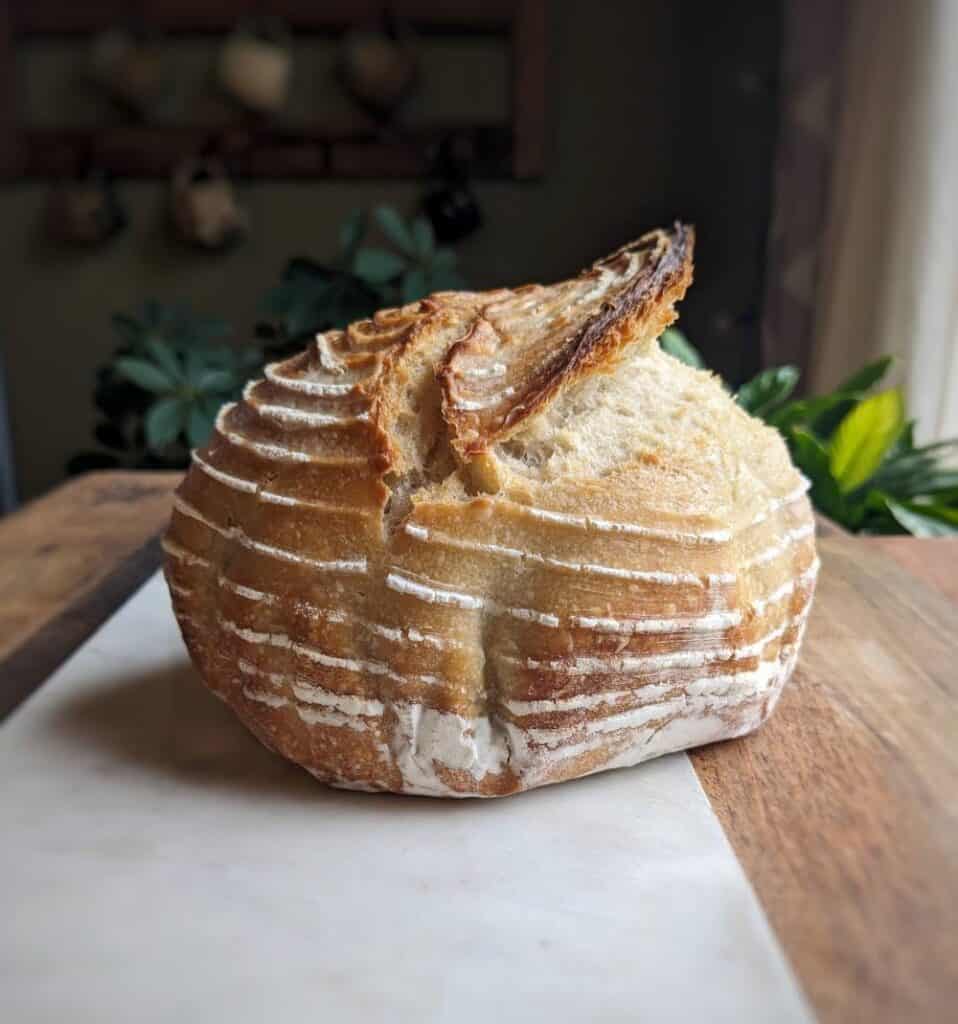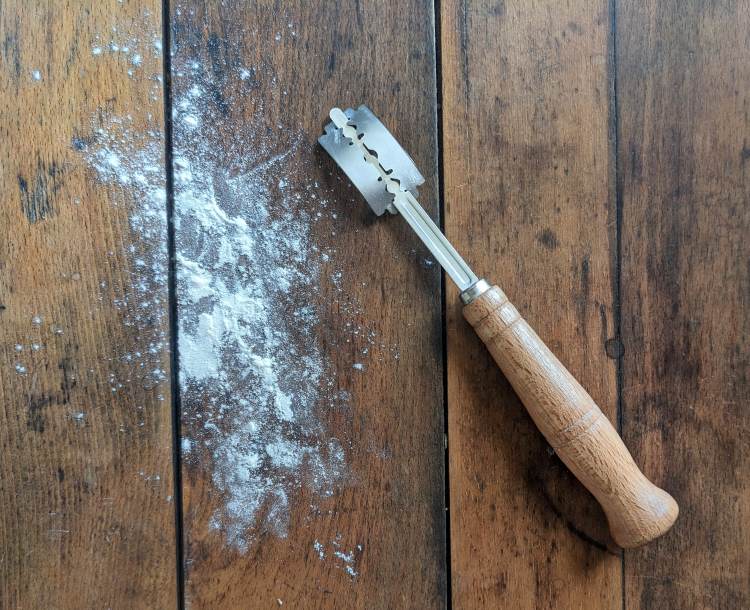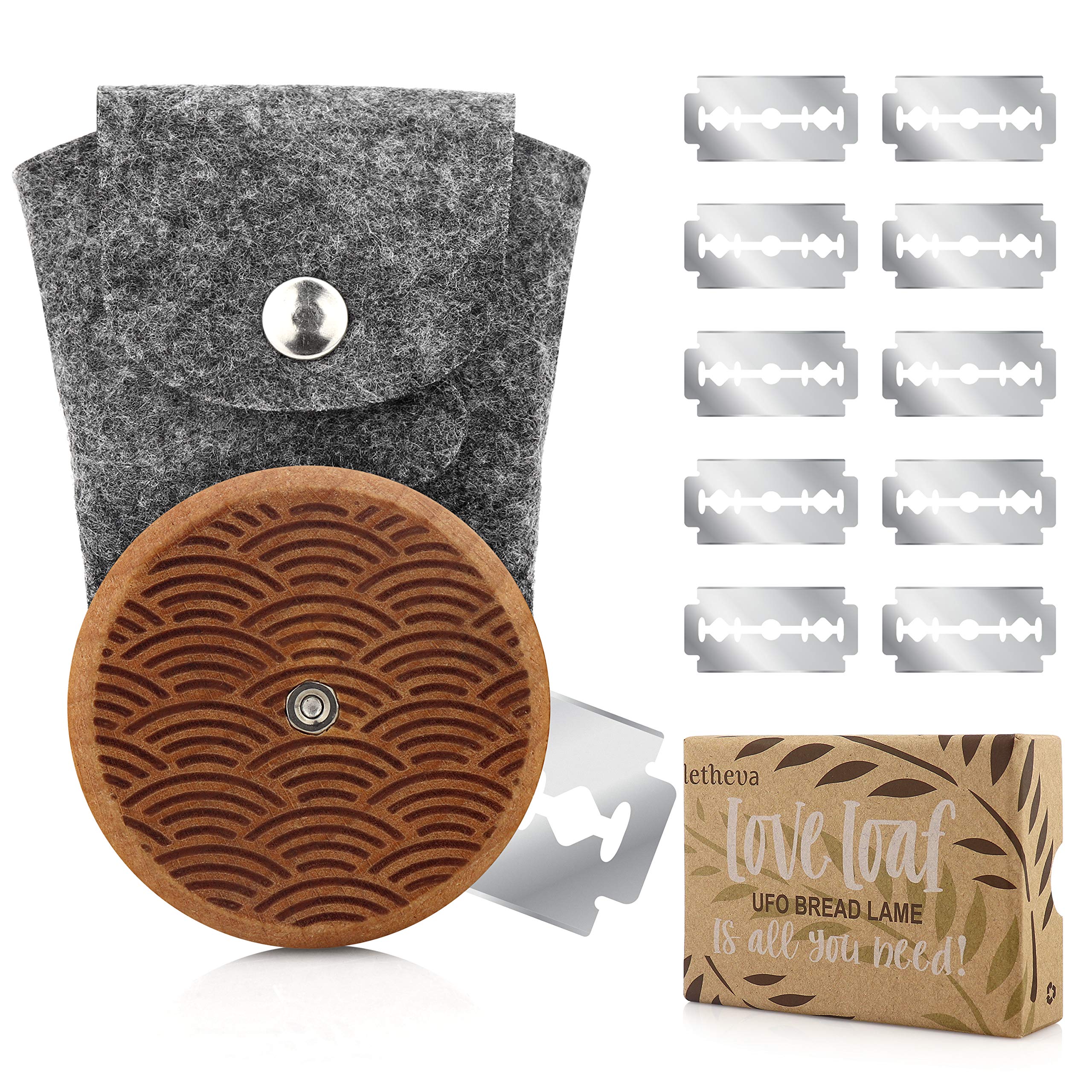We may earn money or products from the companies mentioned in this post.
(Last Updated On: August 31, 2023)Baking sourdough bread at home is an art as much as it is a science. One of the keys to achieving bakery-quality loaves is mastering the technique of scoring your dough. Scoring gives your bread that beautifully designed crust, but also directs the quick expansion of dough for a controlled rise and optimal height.
In simple terms, a lame is a thin, sharp blade attached to a handle, designed specifically for scoring dough. It allows for precision when making cuts and patterns on your dough, affecting the appearance, structure, and rise of your bread.
So do you need a bread lame? My answer – Yes. When you first start out making sourdough bread, you might be using a razor blade (been there, done that – and it works alright, but mine always “tugged” at my dough too much). Believe me, a lame is one of those tools you don’t want to sit on. At under $10, it’s not a huge purchase, but makes the scoring process that much easier (and fun!).
Our two favorite lames
Best Bread Lame
Saint Germain Premium Hand Crafted Bread Lame
Best UFO Bread Lame
Letheva UFO Bread Lame Cutter

Best Bread lame – under $10!
Saint Germain Premium Hand Crafted Bread Lame
My favorite lame is the Saint Germain bread lame because of it’s overall quality and craftsmanship. The wood handle is comfortable and sturdy, and the blade is super sharp making scoring easy!
I was able to achieve clean, precise cuts in my bread dough (something that was much more difficult with just a razor blade when I was first starting out on this sourdough journey!). I think my razor blade was much thicker and stiff – which is why this thin and flexible blade works better!
Replacement blades are easily available and may be covered under the lifetime warranty (I haven’t had to use this yet, so we’ll see!). The protective leather cover is nice to have, too.
Best UFO Bread Lame – Under $11!
If you want to try a UFO style bread lame – I love this one! The Letheva UFO Bread Lame Cutter works well for precision cutting – I like this for baguettes and for some of the smaller details in my sourdough bread designs.
As an artist, I like holding my tools near the execution point – so I hold a pencil near it’s tip and a paintbrush very near the bristles. Apparently I like to be close to my work! That’s why I like using this style, too.
This bread lame comes with 10 blades, a wool felt pouch, and comes in under $11! It’s a nice (and beautiful) tool to have, for a small investment.
What is a Sourdough Bread Lame?
A sourdough bread lame is a specialized tool used by bakers to score, or make shallow cuts, on the surface of sourdough bread. It consists of a razor-sharp, double-sided blade that’s attached to a handle, often made of wood. The handle provides a stable grip for the baker, allowing them to make precise cuts on the dough with ease.
As you use a bread lame, you’ll notice that it’s designed to help you create even, clean slashes on your dough. This is essential for guiding the expansion of the dough during baking, which in turn ensures that your bread has a beautiful, consistent shape and texture.
By the way, lame is pronounced LAHM or LAM 🙂
Scoring
Scoring is the process of making deliberate cuts in the top layer of the risen dough just before baking, using a bread lame or a sharp blade. This technique is particularly important in sourdough bread making, as it directs the expansion and shape of the final loaf by creating intentional weak spots.
When you score sourdough bread, your cuts should be shallow and precise, as this will allow the dough to expand evenly during baking. In addition, scoring also adds an aesthetic element to the finished loaf, as it allows the baker to create unique patterns and designs on the bread’s crust.
To begin scoring your sourdough bread, hold the bread lame at a shallow angle and gently make the desired cuts on the dough’s surface. The cuts should be about 1/4 inch deep and spaced evenly across the dough.
Remember to always use a confident and steady hand — hesitations or inconsistencies in your cuts may affect the appearance and structure of your final loaf.

The Role of a Lame in Baking Sourdough
Preventing Dense Bread
It might not seem like it, but a lame plays an important role in baking sourdough bread. By scoring the surface of the dough, you allow it to rise and expand more efficiently in the oven – so your loaf is at it’s best rise and height. This helps to prevent the final loaf from being too dense and improves the overall texture.
Creating the ‘Ear’
When you score sourdough bread using a lame, you don’t just prevent dense bread, but you also create a unique crust feature known as the ‘ear.’ As the dough bakes and expands, the cuts you made guide the dough’s expansion and can result in an attractive, curled lip along the scored area, resembling an ear. Not only does this ear add to the visual appeal of your loaf, but it also contributes to the crispy crust that is highly desired in artisan sourdough bread.

Bread ‘Rises’ in the Oven
Scoring the dough with a lame allows you to control the direction in which the bread rises in the oven. As the bread bakes, the heat causes the dough to expand, following the path of least resistance. By scoring the dough, you create that path for the dough to expand in a specific direction and pattern.
Techniques for using a Bread Lame
Control
When scoring sourdough bread with a lame, control is essential for achieving precise cuts and patterns. It is crucial to have a steady hand and complete each cut confidently, as hesitation can cause your lame to drag through the dough and create an uneven score. To keep the lame steady, firmly grip the handle, and maintain consistent pressure throughout each cut.
To improve your control when scoring, practice maintaining the optimal angle for your cuts. A 30-45 degree angle works best for basic scoring, which allows the bread to expand nicely without tearing. To make decorative cuts that won’t affect the bread’s overall structure, use a more acute angle while scoring. Remember that practice makes perfect, so the more you score bread, the better your control will become.
Decorative Cuts
Scoring sourdough bread is not only about ensuring a proper rise but also about creating stunning decorative patterns. With a bread lame, you can unleash your creativity and produce eye-catching designs that will elevate your loaf’s presentation. Some popular decorative scoring patterns are:
- Wheat stalks: To achieve this pattern, create a series of curved lines along the length of your loaf, starting from one side and moving towards the center. Repeat this process on the other side, with the curves meeting in the center to resemble a wheat stalk.
- Leaves and vines: To create leaves, make shallow, angled cuts in a leaf shape, with each cut intersecting the previous one. For vines, score a wavy line along the length of your loaf, then add leaves on either side.
- Simple cross: A classic scoring pattern, simply make a deep cut down the center of your loaf, then cross it with another deep cut perpendicular to the first.
Experiment with various patterns to find your favorites, and don’t be afraid to try new designs. By mastering control and learning various decorative cuts, your sourdough bread will not only taste delicious but also look like a work of art.

Tips for Maintaining your Bread Lame
Cleaning
It’s essential to keep your bread lame clean for longevity and optimal performance. After each use, carefully remove the razor blade from the lame handle. Wipe the blade and handle gently with a damp cloth to remove any dough residues. Never use abrasive cleaners that can damage the blade.
Storing
When not in use, keep the lame with its protective cover or storage case, in a cool, dry place, such as a drawer or shelf in your kitchen. Make sure to store it separately from food items to maintain hygiene.
Remember to handle your bread lame with care!
Indispensable Tools for the Sourdough Baker
Banneton
A banneton, also known as a proofing basket, is an essential tool for any sourdough baker. It’s designed to hold your dough during its final rise, giving it a consistent shape and structure. Bannetons come in various sizes and materials, such as wicker, wood, and fabric-lined plastic, allowing you to choose the one that best suits your needs. Using a banneton ensures that your dough remains well-supported and aerated, leading to better oven spring and a more attractive final loaf.
Baker’s Whisk
A baker’s whisk, or dough whisk, is a versatile and efficient tool for mixing your dough. Its unique design allows for easy incorporation of ingredients, reducing the time and effort required in the initial mixing stages. A baker’s whisk also effectively combines wet and dry ingredients without overworking the dough, ensuring a properly developed gluten structure in your sourdough bread. Incorporating this tool into your baking routine can help produce a consistently successful loaf.
Bowl and Bench Scraper
A bowl scraper and a bench scraper are invaluable tools in any sourdough baker’s arsenal. A bowl scraper is perfect for efficiently removing dough from your mixing bowl, ensuring that little to no dough is wasted. It also helps tremendously in efficiently folding and handling your dough during the different stages of the bread-making process.
On the other hand, a bench scraper is a versatile tool that helps in dividing and shaping your dough. Its flat edge allows for precise cuts and easy manipulation of the dough on your work surface, whether it’s for dividing the dough into portions or folding it during the bulk fermentation stage. Additionally, a bench scraper’s straight edge comes in handy for cleaning dried dough and flour residue from your work surface.
Digital Scale
A digital scale is a key element in achieving accurate and consistent results when baking sourdough bread. While using volume measurements, such as cups and tablespoons, can lead to inconsistencies, a digital scale will provide accurate weight measurements for all your ingredients.
Measuring by weight helps to ensure that your dough has the appropriate hydration levels, which in turn, affects the overall texture and taste of your sourdough bread. By investing in a reliable digital scale for your kitchen, you can take your sourdough baking skills to the next level.
Looking for more ideas and techniques to help with beautiful scoring patterns? Take a look at these easy-to-follow videos:
How to score bread with a LAME (Bread Scoring TUTORIAL & 4 Bread Scoring DESIGNS)
8 Sourdough Bread Scoring Tips and Design Ideas
Check out my other articles about Sourdough Bread Making:
Silicone Bread Slings: A Sourdough Bread Making “Must-Have”
Best Sourdough Bread Making Tools: Elevate Your Baking Game!
How To Make Sourdough Starter: An Easy, Step-By-Step Guide



